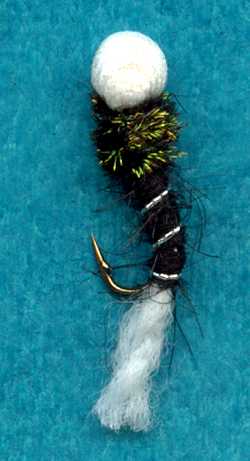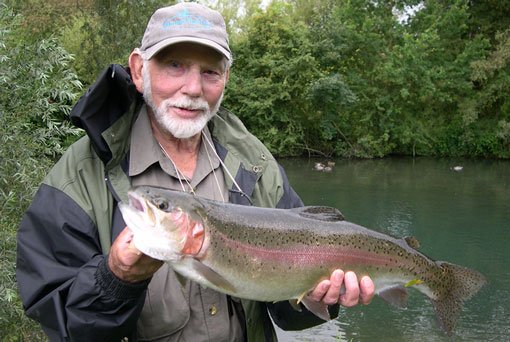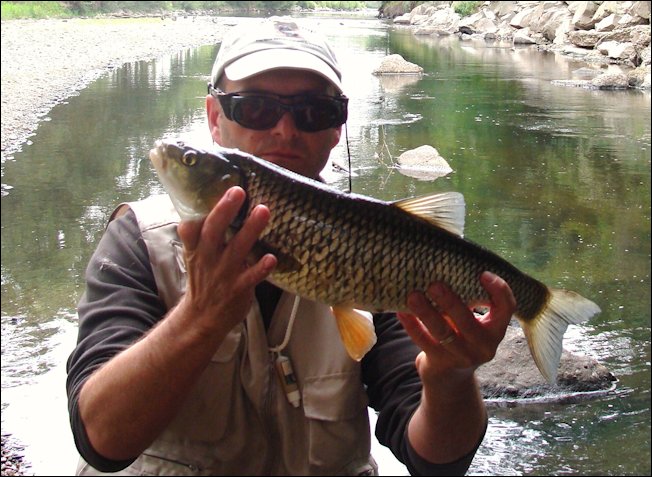Black Suspender Midge Pupa Buzzer
John Goddard has done much to develop the design of the suspender buzzer emerging mayfly nymph. This fly is a superior trout catching fly pattern.

SUSPENDER MIDGE EMERGING BUZZER FLY PATTERNS. Hook size 10 12 14 - $US each
The Ethafoam ball makes sure that the fly hangs correctly suspended from the the surface film. The ball is mistaken by the fish for part of the emerging adult breaking through the top of the nymphal or pupal shuck. Although this was primary a stillwater pattern, it is a good pattern for slow moving rivers and streams where the trout are sipping the pupae from the surface film. In his book John Goddard records that in one season's catch on local rivers he caught over 120 trout, many between three and five pounds, on his suspender midge pupa buzzer.
Tiny Chironomid flies that inhabit lakes and slow-flowing rivers are more commonly known as midges or buzzers. They appear in vast swarms on most still-waters towards the evenings. They can tolerate relatively high levels of pollution. Where they congregate on the windward side of a lake their tiny larvae and pupae are scooped up in large numbers by surface feeding trout. Dr H A Bell developed the original buzzer as an imitation of the midge pupa. They are at their most vulnerable when they make their journey to the surface. The pupae drift gently up to the surface where the survivors struggle to break through the surface film. Many do not make it, especially if the water is very choppy or if a flat calm has allowed oily film to form. At this stage trout patrol the surface sipping in huge quantities of hatching midges.
One of the best indicators of recent buzzer activity is to look for floating shucks or adult buzzers on or near the water. Certain areas will hold fish and buzzers, these being the obvious places to start. It is important to find the right spot. Small tree lined waters are rarely a problem. Mud or silted areas with a reasonable depth of eight to fifteen feet of water are usually good places for buzzer fishing. On a large lake or reservoir try to find a point or headland where a depth of eight to ten feet is within casting range. Try and choose a location where the wind is behind or if from the side it is light. If there is too strong a crosswind then I find it difficult to keep the flies moving nice and slow. Long leaders and headwinds are a recipe for disaster. Your leader will be turned into a tangled ball. On breezy days, selecting areas with some shelter can produce well. They warm up first and thus encourage insects to hatch. Cold winds always slow down hatches.

This is fly fisherman John Goddard designer of the Suspender Buzzer
A strong breeze will push the middle of the fly line around quickly and thus keep the buzzers high in the water. This is okay on an overcast day when the trout are feeding in the upper layers but not on a sunny day when they are feeding in the cooler depths. This problem can be overcome if the cast is made at a much shallower angle to the wind. The wind has less effect on the line and the team of buzzers will fish much deeper and more slowly
The single buzzers can be fished just bellow the surface by greasing all but the last three inches of the leader. If there is a single ripple, an occasional twitch of the fly line is enough to attract attention. In flat calm conditions it is usually better to fish the buzzer static in the surface film. An alternative tactic is to degrease the leader and allow the buzzer to sink very slowly. Using this technique you should be ready for takes 'on the drop', as a trout seizes the buzzer some distance below the surface. I have had many takes sitting this buzzer 2-4 feet below a dry fly used as an indicator and fished close to weed beds in shallow water. In winter this fly has excelled for me when trout are still taking buzzers as part of their diet.
Whether from boat or bank I try a floating line first thing in the morning. Over night many buzzers will have been on the water overnight and some may have even emerge in the early hours. Opportunist fish will often be close to the shore or river bank feeding high in the water after their surface activity. You will be sight fishing for moving fish as they cruise around the margins. A floating line with a team of epoxy buzzer nymphs imitating the pupae, with maybe a suspender buzzer or Shipman's buzzer on the top dropper. I use a larger heavier epoxy buzzer on the point. The top dropper can entice interest from any surface movement and attract any fish looking upwards. As soon as the fish stop showing in any numbers on the surface, and the buzzers have been plentiful, then the epoxy subsurface patterns come into play. (A 'Dropper' is a length of leader tied to the main leader on which other flies are added.)

This 2kg 53cm long carp was caught in France by fly fisherman Herve Raclot using a size 12 Black Suspender Buzzer
The heavier buzzer on the point helps to get the flies down straight in the water as well as aiding turnover in the cast. I find it helpful to present a cast in a straight line. If the flies land in a heap they can often tangle and rarely fish well. Should this happen, in the breeze for example, then a long pull to straighten the leader can be tried. In deep water I use a floating line and a fast sinking Fluorocarbon type of leader material which is nearly invisible under the water. Sometimes the flies end up under the fish so I fish with a buoyant pattern like a Booby Nymph on the point to suspend the remaining flies higher in the water. I count the nymphs down for about 20 seconds before starting the retrieve. If I hit the bottom I do not immediately pull the line in and recast. If you are fishing more than one fly those still on the dropper are still available to tempt the trout. In these situations I just carry on retrieving slowly. In clear water I use leaders up to 18 foot long with thee flies spread about 6 foot apart. If they are too close together the trout may become suspicious. If you are a beginner I suggest that you start off with a 12 foot leader with one fly on the point and another placed 6ft up from there on a dropper. Some fishermen like to place a brash bright fly as 'disturbance' fly on the top dropper with epoxy buzzers behind. The fish often follow the top dropper but as they get near the boat or river bank see the more natural looking buzzer and reject the attraction of the top fly. If it is really windy just use one fly because the more flies you use the more tangles your risk
I like to use a plummet to gauge the depth of the water. Do not buy one. Make one out of a lead weight and a marked line. Once I know how deep the water is I adjust the leader accordingly so that the point fly settles in the correct depth on every cast. If the trout start taking the droppers then this indicates that the fish are moving up away from the bottom to feed. Simply decrease the length of your leader so all you flies are fishing at the correct depth. If when you are casting the one of the buzzers are intercepted before the point fly has reached its correct depth then this will indicate that the fish have changed the depth at which they are fishing again (normally because of a change in water temperature or the weather). It is time to adjust the length of the leader to catch the fish feeding nearer the surface. For beginners always learn to cast with a single fly tied on and only move on to a multi-fly rig having mastered your own casting technique. To achieve a balanced cast space your droppers evenly. If using flies of similar weight and size I try and space them evenly apart. If using flies of different weight and size I try to grade them with the heaviest on the point (end). Using two weighted flies can cause problems as they start pulling in their own direction causing snagging and problems when casting.
Fly Fishing books

